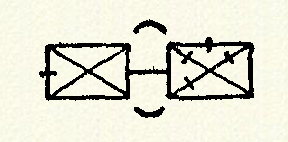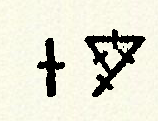CHAPTER X
"Come!"
said the Tracer suddenly; "this won't do. There are too few
symbols to give us a key; too few repetitions to furnish us with
any key basis. Come, Captain, let us use our intellects; let us
talk it over with that paper lying there between us. It's a simple
cipher—a childishly simple one if we use our wits. Now, sir,
what I see repeated before us on this sheet of paper is merely one
of the forms of a symbol known as Solomon's Seal. The symbol is,
as we see, repeated a great many times. Every seal has been dotted
or crossed on some one of the lines composing it; some seals are
coupled with brackets and armatures."

"What of it?" inquired Harren
vacantly.
"Well,
sir, in the first place, that symbol is supposed to represent the
spiritual and material, as you know. What else do you know about
it?"

"Nothing. I bought a book about it,
but made nothing of it."
"Isn't
it supposed," asked Mr. Keen, "to contain within itself
the nine numerals, 1, 2, 3, 4, 5, 6, 7, 8, 9, and even the zero
symbol?"
"I believe
so."
"Exactly.
Here's the seal

Now I'll mark the one, two, and three by crossing the lines, like
this:
one,

two,

three,

Now, eliminating all lines not crossed there remains
the one,

the two,

the three,

And here is the entire series:

and the zero—"

A sudden excitement stirred Harren; he leaned over the paper, gazing
earnestly at the cipher; the Tracer rose and glanced around the
room as though in search of something.
"Is there a telephone here?"
he asked.
"For Heaven's sake, don't give
this up just yet," exclaimed Harren. "These things mean
numbers; don't you see? Look at that!" pointing to a linked
pair of seals,

"That means the number nineteen! You can form it by using only
the crossed lines of the seal.

Don't you see, Mr. Keen?"
"Yes, Captain Harren, the cipher
is, as you say, very plain; quite as easy to read as so much handwriting.
That is why I wish to use your telephone—at once, if you please."
"It's in my bedroom; you don't
mind if I go on working out this cipher while you're telephoning?"
"Not in the least," said
the Tracer blandly. He walked into the Captain's bedroom, closing
the door behind him; then he stepped over to the telephone, unhooked
the receiver, and called up his own headquarters.
"Hello. This is Mr. Keen. I
want to speak to Miss Borrow."
In a few moments Miss Borrow answered:
"I am here, Mr. Keen."
"Good. Look up the name Inwood.
Try New York first—Edith Inwood is the name. Look sharp, please;
I am holding the wire."
He held it for ten full minutes;
then Miss Borrow's low voice called him over the wire.
"Go ahead," said the Tracer
quietly.
"There is only one Edith Inwood
in New York, Mr. Keen—Miss Edith Inwood, graduate of Barnard,
1902—left an orphan 1903 and obliged to support herself—became
an assistant to Professor Boggs of the Museum of Inscriptions. Is
considered an authority upon Arabian cryptograms. Has written a
monograph on the Herati symbol—a short treatise on the Swastika.
She is twenty-four years of age. Do you require further details?"
"No," said the Tracer;
"please ring off."
Then he called up General Information.
"I want the Museum of Inscriptions. Get me their number, please."
After a moment: "Is this the Museum of Inscriptions?"
"Is Professor Boggs there?"
"Is this Professor Boggs?"
"Could you find time to decipher
an inscription for me at once?"
"Of course I know you are extremely
busy, but have you no assistant who could do it?"
"What did you say her name is?
Miss Inwood?"
"Oh! And will the young lady
translate the inscription at once if I send a copy of it to her
by messenger?"
"Thank you very much, Professor.
I will send a messenger to Miss Inwood with a copy of the inscription.
Good-by."
He hung up the receiver, turned thoughtfully,
opened the door again, and walked into the sunlit living room.
"Look here!" cried the
Captain in a high state of excitement. "I've got a lot of numbers
out of it already."
"Wonderful!" murmured the
Tracer, looking over the young man's broad shoulders at a sheet
of paper bearing these numbers:
9 — 14 — 5 — 22 — 5 — 18 — 19
— 1 — 23 — 25 — 15 — 21 — 2
— 21 — 20 — 15 — 14 — 3 — 5
— 9 — 12 — 15 — 22 — 5 — 25
— 15 — 21 — 5 — 4 — 9 — 20 —
8 — 9 — 14 — 23 — 15 — 15 —
4.
"Marvelous!" repeated the
Tracer, smiling. "Now what do you suppose those numbers can
stand for?"
"Letters!" announced the
Captain triumphantly. "Take the number nine, for example. The
ninth letter in the alphabet is I! Mr. Keen, suppose we try writing
down the letters according to that system!"
"Suppose we do," agreed
the Tracer gravely.
So, counting under his breath, the
young man set down the letters in the following order, not attempting
to group them into words:
INEVERSAWYOUBUTONCEILOVEYOUEDITHINWOOD.
Then he leaned back, excited, triumphant.
"There you are!" he said;
"only, of course, it makes no sense." He examined it in
silence, and gradually a hopeless expression effaced the animation.
"How the deuce am I going to separate that mass of letters
into words?" he muttered.
"This way," said the Tracer,
smilingly taking the pencil from his fingers, and he wrote: I —
NEVER — SAW — YOU — BUT — ONCE. I —
LOVE — YOU. EDITH INWOOD.
Then he laid the pencil on the table
and walked to the window.
Once or twice he fancied that he
heard incoherent sounds behind him. And after a while he turned,
retracing his steps leisurely. Captain Harren, extremely pink, stood
tugging at his short mustache and studying the papers on the desk.
"Well?" inquired the Tracer,
amused.
The young man pointed to the translation
with unsteady finger. "W-what on earth does that mean?"
he demanded shakily. "Who is Edith Inwood? W-what on earth
does that cryptogram mean on the window pane in the photograph?
How did it come there? It isn't on my window pane, you see!"
The Tracer said quietly: "That
is not a photograph of your window."
"What!"
"No, Captain. Here! Look at
it closely through this glass. There are sixteen small panes in
that sash; now count the panes in your window—eight! Besides,
look at that curtain. It is made of some figured stuff like chintz.
Now, look at your own curtain yonder! It is of plain velour."
"But—but I took that photograph!
She stood there—there by that very window!"
The Tracer leaned over the photograph,
examining it through the glass. And, studying it, he said: "Do
you still see her in this photograph, Captain Harren?"
"Certainly. Can you not see
her?"
"No," murmured the Tracer,
"but I see the window which she really stood by when her phantom
came here seeking you. And that is sufficient. Come, Captain Harren,
we are going out together."
The Captain looked at him earnestly;
something in Mr. Keen's eyes seemed to fascinate him.
"You think that—that it's
likely we are g-going to see—her!" he faltered.
"If I were you," mused
the Tracer of Lost Persons, joining the tips of his lean fingers
meditatively—"If I were you I should wear a silk hat
and a frock coat. It's—it's afternoon, anyhow," he added
deprecatingly, "and we are liable to make a call."
Captain Harren turned like a man
in a dream and entered his bedroom. And when he emerged he was dressed
and groomed with pathetic precision.
"Mr. Keen," he said, "I—I
don't know why I am d-daring to hope for all s-sorts of things.
Nothing you have said really warrants it. But somehow I'm venturing
to cherish an absurd notion that I may s-see her."
"Perhaps," said the Tracer,
smiling.
"Mr. Keen! You wouldn't say
that if—if there was no chance, would you? You wouldn't dash
a fellow's hopes—"
"No, I wouldn't," said
Mr. Keen. "I tell you frankly that I expect to find her."
"To-day?"
"We'll see," said Mr. Keen
guardedly. "Come, Captain, don't look that way! Courage, sir!
We are about to execute a turning movement; but you look like a
Russian general on his way to the south front."
Harren managed to laugh; they went
out, side by side, descended the elevator, and found a cab at the
porte-cochère. Mr. Keen gave the directions and followed
the Captain into the cab.
"Now," he said, as they
wheeled south, "we are first going to visit the Museum of Inscriptions
and have this cipher translation verified. Here is the cipher as
I copied it. Hold it tightly, Captain; we've only a few blocks to
drive."
Indeed they were already nearly there.
The hansom drew up in front of a plain granite building wedged in
between some rather elaborate private dwelling-houses. Over the
door were letters of dull bronze:
AMERICAN MUSEUM OF INSCRIPTIONS
and the two men descended and entered
a wide marble hall lined with glass-covered cabinets containing
plaster casts of various ancient inscriptions and a few bronze and
marble originals. Several female frumps were nosing the exhibits.
An attendant in livery stood in the
middle distance. The Tracer walked over to him. "I have an
appointment to consult Miss Inwood," he whispered.
"This way, sir," nodded
the attendant, and the Tracer signaled the Captain to follow.
They climbed several marble stairways,
crossed a rotunda, and entered a room—a sort of library. Beyond
was a door which bore the inscription:
ASSISTANT CURATOR
"Now," said the Tracer of Lost Persons in a low voice
to Captain Harren, "I am going to ask you to sit here for a
few minutes while I interview the assistant curator. You don't mind,
do you?"
"No, I don't mind," said
Harren wearily, "only, when are we going to begin to search
for—her?"
"Very soon—I may say extremely
soon," said Mr. Keen gravely. "By the way, I think I'll
take that sheet of paper on which I copied the cipher. Thank you.
I won't be long."
The attendant had vanished. Captain
Harren sat down by a window and gazed out into the late afternoon
sunshine. The Tracer of Lost Persons, treading softly across the
carpeted floor, approached the sanctuary, turned the handle, and
walked in, carefully closing the door behind him.
There was a young girl seated at
a desk by an open window; she looked up quietly as he entered, then
rose leisurely.
"Miss Inwood?"
"Yes."
She was slender, dark-eyed, dark-haired—a
lovely, wholesome young creature; gracious and graceful. And that
was all—for the Tracer of Lost Persons could not see through
the eyes of Captain Harren, and perhaps that is why he was not able
to discern a miracle of beauty in the pretty girl who confronted
him—no magic and matchless marvel of transcendent loveliness—only
a quiet, sweet-faced, dark-eyed young girl whose features and figure
were attractive in the manner that youth is always attractive. But
then it is a gift of the gods to see through eyes anointed by the
gods.
The Tracer touched his gray mustache
and bowed; the girl bowed very sweetly.
"You are Mr. Keen," she
said; "you have an inscription for me to translate."
"A mystery for young eyes to
interpret," he said, smiling. "May I sit here—and
tell my story before I show you my inscription?"
"Please do," she said,
seating herself at her desk and facing him, one slender white hand
supporting the oval of her face.
The Tracer drew his chair a little
forward. "It is a curious matter," he said. "May
I give you a brief outline of the details?"
"By all means, Mr. Keen."
"Then let me begin by saying
that the inscription of which I have a copy was probably scratched
upon a window pane by means of a diamond."
"Oh! Then—then it is not
an ancient inscription, Mr. Keen."
"The theme is ancient—the
oldest theme in the world—love! The cipher is old—as
old as King Solomon." She looked up quickly. The Tracer, apparently
engrossed in his own story, went on with it. "Three years ago
the young girl who wrote this inscription upon the window pane of
her—her bedroom, I think it was—fell in love. Do you
follow me, Miss Inwood?"
Miss Inwood sat very still—wide,
dark eyes fixed on him.
"Fell in love," repeated
the Tracer musingly, "not in the ordinary way. That is the
point, you see. No, she fell in love at first sight; fell in love
with a young man whom she never before had seen, never again beheld—and
never forgot. Do you still follow me, Miss Inwood?"
She made the slightest motion with
her lips.
"No," mused the Tracer
of Lost Persons, "she never forgot him. I am not sure, but
I think she sometimes dreamed of him. She dreamed of him awake,
too. Once she inscribed a message to him, cutting it with the diamond
in her ring on the window pane—"
A slight sound escaped from Miss
Inwood's lips. "I beg your pardon," said the Tracer, "did
you say something?"
The girl had risen, pale, astounded,
incredulous.
"Who are you?" she faltered.
"What has this—this story to do with me?"
"Child," said the Tracer
of Lost Persons, "the Seal of Solomon is a splendid mystery.
All of heaven and earth are included within its symbol. And more,
more than you dream of, more than I dare fathom; and I am an old
man, my child—old, alone, with nobody to fear for, nothing
to dread, not even the end of all—because I am ready for that,
too. Yet I, having nothing on earth to dread, dare not fathom what
that symbol may mean, nor what vast powers it may exert on life.
God knows. It may be the very signet of Fate itself; the sign manual
of Destiny."
He drew the paper from his pocket,
unrolled it, and spread it out under her frightened eyes.
"That!" she whispered,
steadying herself blindly against the arm he offered. She stood
a moment so, then, shuddering, covered her eyes with both hands.
The Tracer of Lost Persons looked at her, turned and opened the
door.
"Captain Harren!" he called
quietly. Harren, pacing the anteroom, turned and came forward. As
he entered the door he caught sight of the girl crouching by the
window, her face hidden in her hands, and at the same moment she
dropped her hands and looked straight at him.
"You!" she gasped.
The Tracer of Lost Persons stepped
out, closing the door. For a moment he stood there, tall, gaunt,
gray, staring vacantly into space.
"She was beautiful—when
she looked at him," he muttered.
For another minute he stood there,
hesitating, glancing backward at the closed door. Then he went away,
stooping slightly, his top hat held close against the breast of
his tightly buttoned frock coat.